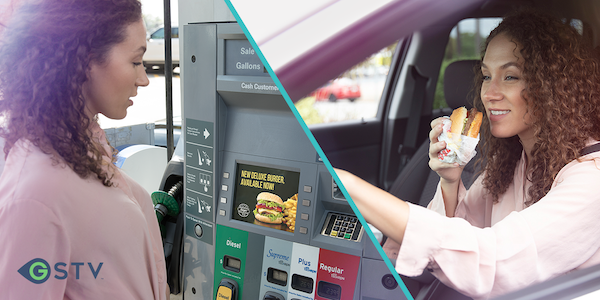This article is sponsored by GSTV.
It turns out fueling up can predict more about consumer behavior than marketers might expect.
A recent study produced by Mastercard and GSTV revealed fueling up leads to significant patterns in consumer spending. After analyzing nearly a year’s worth of aggregated, anonymized transaction data on Mastercard’s network, the study found consumers spend 1.7x more in the first three hours following a fuel transaction than those who haven’t just fueled up. Across select purchase categories – such as quick service restaurants (QSR) – the likelihood to spend after fueling up rises even higher. In fact, consumers were 2.8x more likely to spend at a QSR after fueling, with an average transaction size of $10.48 in the category.
The results confirmed GSTV’s long-standing belief that consumers don’t just fuel up and go home – fueling is actually part of a larger trip, which often includes shopping.
“This new data from Mastercard validates our fundamental hypothesis of the GSTV audience – they’re mobile, spending more in key categories at the most valuable moments of the consumer journey, and hence creating a natural opportunity for authentic brand engagement with measurable outcomes,” said Sean McCaffrey, President and CEO at GSTV.
Within the QSR category, Mastercard found that breakfast experienced the largest lift in sales following a fuel up, while dinner purchases accounted for the most spent per transaction – averaging $13.23. Other high-frequency, post-fuel shopping destinations included big box stores, grocery stores, drug stores and casual dining chains.
So what lessons can these new consumer insights offer to marketers looking to maximize the impact of their ad spend?
Eric Z. Sherman, SVP, Insights and Analytics at GSTV, believes the data suggest that recency-of-exposure is an underutilized media tactic for influencing consumer behavior.
“It’s well-established that consumers are far more likely to purchase brands that are top-of-mind,” said Sherman. “The challenge for advertisers has been getting in front of shoppers right before they’re about to make a purchase. This new research from Mastercard identifies the fuel station as a critical juncture on the path to purchase for a number of different categories.”
“A fuel transaction precedes significantly elevated consumer spending, and represents an opportunity to influence behavior while the customer is in a shopping mindset, at a moment that is both physically and temporally close to a purchase decision,” Sherman added.
Working with publishers who can provide access to these highly valuable locations – while identifying the moments when consumers are most receptive to different product messages – is a proven way to strengthen return on advertising spend. According to ongoing GSTV research in collaboration with Placed, a best-in-class foot-traffic attribution provider, ad campaigns on GSTV typically produce a 15-20% lift in retail store visitation versus a matched control group.
As marketers seek to better understand their customers, this kind of data-driven, holistic view of the consumer has become increasingly valuable – particularly when tied to hard metrics like credit card spending.
“GSTV is unique in the media landscape in that the customer experience is defined by a transaction,” Sherman said. “This gives us an especially rich data set to work with, tied directly to what advertisers care about most – consumer spending.”
Equipped with a complete view of their consumers – both pre and post ad impression – marketers are empowered to develop media strategies that span the entire customer lifecycle and enhance consumer experiences at every touchpoint along the way.














